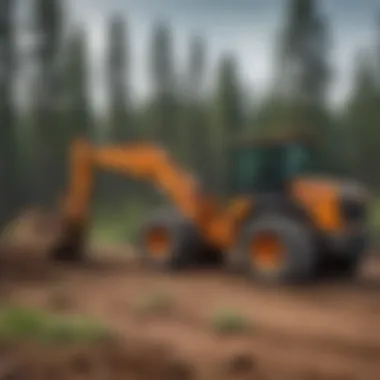Understanding the Cost to Clear Ten Acres of Land


Intro
Clearing ten acres of land is a significant undertaking that requires not only physical labor but also financial investment and careful consideration of various factors. The cost associated with such a project can vary widely, influenced by the terrain, location, and specific methodologies used. Understanding these elements is crucial for landowners and forestry professionals who aim to make informed decisions.
This article provides a comprehensive examination of the costs involved in land clearing. From equipment and labor expenses to permitting and environmental impacts, every aspect is explored in detail. By highlighting these critical components, readers gain insight into the financial implications, enabling them to plan and execute land clearing projects efficiently.
Understanding Woodland Ecosystems
Importance of Biodiversity in Forests
Woodland ecosystems are characterized by their rich biodiversity. This diversity plays a vital role in the overall health and function of forests. A variety of species contributes to ecological stability, resilience against pests, and adaptability to changing climates. For instance, diverse plant species support different animal populations, which in turn help in pollination and natural pest control.
When considering land clearing, it's essential to recognize that removal of vegetation can disrupt these interactions.
Role of Forests in Climate Regulation
Forests hold enormous significance in climate regulation. They act as carbon sinks, absorbing carbon dioxide and releasing oxygen. This process mitigates climate change by reducing greenhouse gases in the atmosphere. When ten acres of land is cleared, the immediate impact on carbon sequestration can be profound. It's crucial for landowners to weigh the environmental costs against their goals for the land.
Sustainable Forestry Practices
Principles of Sustainable Forestry
Sustainable forestry aims to balance the economic needs of landowners with the ecological integrity of the forest. This involves careful planning to ensure that clearing practices do not compromise the forest's ability to regenerate. Key principles include:
- Maintaining biodiversity.
- Protecting water resources.
- Ensuring soil health.
By following these principles, landowners can mitigate negative impacts while optimizing the use of their land.
Case Studies of Successful Implementations
Analyzing successful implementations of sustainable forestry practices reveals the potential for positive outcomes. Many forestry professionals have adopted strategies that integrate both ecological and economic objectives, illustrating that land clearing does not have to result in detrimental impacts. For example, in certain cases, selective clearing allows for the harvest of timber while preserving essential habitats.
Woodland Stewardship Techniques
Forest Management Plans
A well-structured forest management plan is fundamental for anyone looking to clear land responsibly. This plan should address the specific goals of the landowner alongside environmental preservation strategies. Key components often include:
- Inventory of existing resources.
- Benefits of specific species.
- Future planting schedules.
Having a clear management plan can prevent future conflicts and ensure compliance with local regulations.
Conservation Strategies
Incorporating conservation strategies into land clearing efforts benefits both the environment and the landowner. Strategies may encompass:
- Creating buffer zones around waterways.
- Employing erosion control methods.
- Replanting native vegetation post-clearing.
Through these strategies, landowners can contribute to the sustainability of local ecosystems while achieving their land development goals.
Effective land management creates a harmonious balance between human needs and ecological preservation.
Intro to Land Clearing Costs
Understanding the cost associated with land clearing is critical for landowners, forestry professionals, and investors alike. This segment provides vital insight into the financial aspects of clearing ten acres of land, a task that often demands a considerable upfront investment. Land clearing is not merely a physical endeavor; it involves financial planning and resource allocation that varies significantly based on a multitude of factors. By grasping these costs, stakeholders can make informed decisions that ensure project success.
Defining Land Clearing
Land clearing refers to the process of removing trees, shrubs, and other vegetation from a particular area to prepare it for a specified purpose. This can include agricultural development, construction, or creating recreational spaces. The definition extends beyond the physical act itself; it incorporates considerations related to environmental impact, regulatory compliance, and future land use plans. Properly defining land clearing sets the stage for understanding the associated costs and methodologies.
Purpose of Clearing Land
The objective behind clearing land can vary widely among different stakeholders. Common reasons include:


- Agricultural Development: Clearing land to cultivate crops or raise livestock requires significant investment and planning.
- Commercial Construction: This often necessitates a clean slate for buildings and infrastructure, which adds to the complexities of the project.
- Recreational Use: Landowners may want to create parks or facilities which need cleared spaces to accommodate visitors.
Moreover, understanding the purpose is essential for estimating costs accurately and considering necessary permits. Land use intention informs how thoroughly the land must be cleared and which equipment will be most efficient, thus impacting the overall financial considerations of the project.
Factors Influencing Clearing Costs
Understanding the costs associated with clearing land is essential for any landowner or forestry professional. The overall expenses are not determined by a single factor but rather a compilation of several influences. Key elements that play a role in determining these costs include terrain type, vegetation density, and proximity to urban areas. Grasping these factors allows for a more accurate financial forecast and better decision-making when planning land clearing projects.
Terrain Types
Terrain type significantly impacts the complexity and cost of land clearing. Different terrains present various challenges that can change the price dramatically. For instance, flat land is generally easier and less costly to clear compared to hilly or rocky areas, which might necessitate specialized equipment. While operating on flat terrain may involve simple bulldozers, hilly regions may require excavators or even helicopters for heavy loads.
Moreover, soil quality can affect machinery performance and operational efficiency. Dense clay or rocky soils can lead to wear and tear on machinery, increasing maintenance costs and downtime. Thus, understanding the existing terrain is crucial for accurate cost estimation.
Vegetation Density
The density of vegetation also significantly affects clearing costs. Areas with thick tree growth and underbrush require more effort, time, and equipment compared to those with lighter vegetation. For example, a heavily forested area might require chainsaws, stump grinders, and bulldozers to clear, while a sparsely populated field may only need a simple brush cutter.
This variability can lead to increased labor costs as well, as denser vegetation may necessitate more workers or longer working hours to achieve the desired clearance. It’s often advised to conduct a vegetation assessment before beginning any clearing work to understand the potential expenses involved thoroughly.
Proximity to Urban Areas
Lastly, the proximity of the land to urban areas can influence costs significantly. Often, clearing projects located near cities or towns face higher expenses due to stricter regulations, increased transportation costs for machinery, and availability of skilled labor. Urban projects may require specific permits and compliance with local zoning laws, adding an additional layer of expenses.
Conversely, rural projects might encounter fewer regulatory requirements, which could lower costs. However, factors like access to roadways and transportation logistics must still be considered.
Estimating the Cost to Clear Ten Acres
Estimating the cost to clear ten acres of land is essential for landowners and professionals. Understanding these costs helps in making informed financial decisions and prepares you for potential challenges. When considering a land clearing project, several elements come into play such as labor, equipment, permits, and environmental impacts. All these factors can significantly alter the overall budget. This section aims to dissect the costs involved, providing clarity for the decision-making process.
Average Cost Estimates
Land clearing costs vary based on several variables. On average, clearing ten acres can range from $2,500 to $10,000. Specific factors affect this estimate, including:
- Terrain type: Flat land is usually easier to clear than hilly or rocky areas.
- Vegetation density: Heavily wooded areas will often cost more due to the amount of work required.
- Local labor rates: Costs for hiring a crew can differ significantly by location.
It's important to not only consider these estimates but also to conduct your own research. Consult local contractors to get quotes specific to your area and the specifics of your land. Some expenditures might seem straightforward, but hidden costs can emerge, such as the disposal of debris. Therefore, always account for potential additional fees when budgeting.
Regional Cost Variations
Understanding regional cost variations is crucial when evaluating land clearing expenses. Costs can fluctuate significantly depending on geographic area and market conditions.
- Urban vs. rural: Generally, urban areas may bear higher labor costs and permit fees than rural spaces, mainly due to higher demand for services.
- State regulations: Different states have various regulations that can impact costs. Some may require expensive permits, impacting the overall budget.
- Accessibility: Remote locations may increase costs. Hauling away equipment or materials takes more time and resources.
Consider researching local market trends. For example, a study conducted by Land Clearing Today reveals that regions with burgeoning real estate developments may see a surge in demand for land clearing. Conversely, rural areas may have operators willing to offer competitive rates to draw customers.
"Awareness of regional cost variations can save landowners significant amounts in clearing expenses."
When considering clearing ten acres, every detail counts. Understanding these factors provides a clearer picture, allowing better financial and environmental decisions for prospective land clearers.
Common Equipment Used in Land Clearing
Clearing land effectively requires specialized equipment. This ensures the process is completed efficiently and safely. The selection of machinery influences overall costs and timeframes significantly. Understanding the specific equipment used in land clearing helps landowners and professionals make informed choices regarding their projects.
Bulldozers
Bulldozers are among the most essential machines in land clearing. Known for their powerful engine and a broad, flat blade, they push earth and vegetation with ease. The ability to move large volumes of soil makes bulldozers extremely effective in creating access roads and leveling land for development.
Benefits of using bulldozers:
- Efficiency: Their robust nature allows them to handle tough terrains, reducing time spent on clearing.
- Versatility: Besides clearing, they can assist in grading and site preparation for future construction.
- Durability: Built to withstand harsh conditions, bulldozers need less maintenance than lighter machinery.
However, operating a bulldozer requires skilled personnel. Misuse can lead to costly damage or injury. It is prudent to ensure qualified operators manage these machines.


Excavators
Excavators play a crucial role in land clearing as well. They come equipped with a rotating platform and a long arm, which can extend to access localised areas. This makes excavators particularly useful in regions cluttered with trees and shrubs.
Key aspects of excavators include:
- Precision: They can reach difficult areas, making them ideal for sites with dense vegetation.
- Attachments: Various attachments, like buckets and grapples, enhance their functionality. This allows for specialized tasks such as uprooting trees or digging trenches.
- Mobility: Many models come with tracks, providing stability on uneven ground.
Their operation demands trained individuals. An inexperienced operator may not maximize the machine's potential, leading to inefficiencies.
Chainsaws
Chainsaws contribute a more manual approach to land clearing, often working in concert with heavy machinery. They are particularly useful for felling trees and cutting them into manageable pieces. While they may seem simple, chainsaws require skill to use safely and effectively.
Considerations for chainsaws:
- Portability: They are easy to transport and can be used in tight spaces inaccessible to bulldozers or excavators.
- Cost-Effective: Compared to larger equipment, chainsaws are relatively inexpensive, making them a common choice for smaller clearing jobs.
- Skill Required: Users must understand safety protocols and best practices. Improper use can result in serious accidents.
Important Note: Always prioritize safety when using chainsaws, as chainsaw injuries are common. Proper training can mitigate risks.
Labor Costs in Land Clearing
Labor costs are a significant component of the overall expenses when clearing land. This aspect is crucial for anyone considering land clearing, as it directly impacts the project budget and timeline. Applying the right labor resources can lead to efficient land clearing while keeping costs in check. The proper assessment of labor costs ensures that landowners are not only prepared for the financial commitment but also understand the quality and expertise needed to get the job done effectively.
In this section, we will analyze two key elements of labor costs: hourly wages for crews and the necessity for training and expertise.
Hourly Wages for Crews
Hourly wages for land clearing crews can fluctuate based on various factors. These factors include regional differences, the complexity of the job, and the experience level of the workers. In general, labor costs can vary widely across different states and regions. For example, urban areas may have higher labor costs due to a higher cost of living compared to rural areas.
Additionally, crew experience plays a crucial role. More experienced workers typically command higher wages but can accomplish tasks more efficiently than less experienced crew members. This efficiency can lead to reduced total project costs despite the higher initial labor rates.
"Labor costs can represent up to 30-50% of total clearing expenses. Understanding this breakdown helps landowners budget more accurately."
Training and Expertise
Investing in training and expertise is vital for any land clearing project. Proper training ensures that crews operate equipment safely and effectively, minimizing risks of accidents and equipment damage. Trained professionals can also adapt to various terrains and vegetation types, optimizing the land clearing process.
Moreover, skilled workers are more likely to follow best practices that help reduce environmental impacts and comply with regulations. The long-term benefits of hiring well-trained crews often outweigh the short-term costs associated with their higher wages. Additionally, ensuring that workers are properly trained can lead to fewer operational errors, resulting in overall project efficiency and effectiveness.
Permits and Regulatory Considerations
In the process of clearing land, obtaining the necessary permits and complying with regulations is crucial. Not only is it a legal obligation, but it also influences the overall cost and timeline of the project. Failing to secure the appropriate permits may result in fines, delays, or even forced cessation of work. Understanding these requirements can help avoid unnecessary headaches and financial burdens.
Obtaining permits ensures that land clearing is conducted in a manner that respects local regulations and environmental considerations. These permits serve various purposes:
- Protection of local ecosystems
- Regulation of waste disposal
- Compliance with zoning laws
Navigating the permitting process is often complicated. Therefore, landowners should start by checking local government offices or environmental agencies for guidelines. Each region may have unique requirements depending on the land's use, location, and existing vegetation.
Types of Permits Required
Land clearing typically requires several types of permits, depending on local laws and environmental regulations. Common permits include:
- Land Use Permit: This permit allows landowners to utilize the land for specific purposes. Restrictions may apply based on zoning laws.
- Environmental Impact Assessment (EIA): In many localities, an EIA must be conducted to evaluate potential environmental effects from clearing activities.
- Tree Removal Permit: If significant tree removal is involved, a specific permit may be necessary to ensure compliance with conservation laws.
- Stormwater Management Permit: This protects against flooding and erosion by regulating how water is managed on the property after clearing.
The exact permits required vary widely and landowners should consult local regulations.
Compliance Costs
Compliance costs are another significant consideration when planning land clearing. These costs often include:
- Permit Application Fees: Costs for applying for permits vary by region and permit type. These fees can add up quickly.
- Environmental Studies: If an EIA or similar assessment is required, landowners must account for the costs of conducting these studies which may require hiring specialized consultants.
- Mitigation Costs: If adverse impacts are identified during environmental reviews, measures may need to be taken to mitigate effects. This can include replanting trees or restoring habitats, incurring further expenses.
- Fines for Non-Compliance: Ignoring regulations or failing to obtain permits can lead to hefty fines, which can severely impact your budget.


Understanding permits and regulatory considerations is key to effective land clearing. It ensures that land is cleared legally and sustainably while minimizing risks and unexpected costs. Therefore, it is prudent to conduct thorough research on the requirements before starting any land clearing project.
Environmental Impact of Land Clearing
Understanding the environmental impact of land clearing is crucial. It provides insight into how land management practices can affect local ecosystems and sustainability. The clearing of land can lead to significant changes in biodiversity, soil quality, and water resources. For professionals involved in forestry and land management, recognizing these impacts is imperative for guiding responsible practices and ensuring the health of the environment for future generations.
Ecosystem Disruption
When land is cleared, it directly disrupts the ecosystems that inhabit that area. Different species, which may rely on specific plants and habitats, can face habitat loss. This can result in decreased biodiversity as certain species may not survive the loss of their natural environment. Additionally, when trees and vegetation are removed, the animal species that depend on them for shelter and food may also vanish.
According to studies, a significant percentage of species loss is directly linked to habitat destruction due to agricultural and urban development.
Land clearing can pose threats to both terrestrial and aquatic ecosystems. The alteration of land can change the flow of water and affect wetland areas, which play a critical role in filtering water and supporting wildlife. To mitigate these effects, conservation practices should be implemented. These can include leaving buffer zones, which are areas of vegetation left intact around water sources to reduce runoff and protect sensitive habitats.
Soil Erosion Risks
Another crucial aspect of land clearing is the risk of soil erosion. When vegetation is removed, soil is left bare and can be easily washed away by rain or blown away by wind. This can lead to several issues, such as:
- Loss of fertile topsoil, which is essential for plant growth
- Decreased soil health due to the disruption of microbial communities
- Increased sediment in waterways, harming aquatic life and leading to water quality issues
As the soil erodes, landowners may face additional costs associated with rehabilitation. Preventing soil erosion is vital, and practices like contour plowing, planting cover crops, and using erosion control blankets can help retain soil integrity. It is essential to recognize that addressing the environmental impacts of land clearing not only preserves biodiversity but also ensures the viability of the land for future agricultural or developmental purposes.
Sustainable Practices in Land Clearing
In the contemporary discourse around land clearing, sustainable practices have emerged as a vital component, shaping the future methodology of this operation. By integrating environmentally friendly techniques, landowners can minimize detrimental impacts on the ecosystem while achieving their land management goals. Emphasizing sustainability is not only an ethical decision but also a financially savvy move that can result in considerable long-term benefits.
There are several aspects of sustainable land clearing practices that deserve attention. These include the careful planning of clearing operations, the choice of equipment and techniques, and considerations for subsequent land use. These practices aim to reduce soil degradation, preserve biodiversity, and maintain natural water cycles, thus showcasing the interconnected nature of ecological health and responsible land management.
Minimal Impact Techniques
Minimal impact techniques focus on reducing disturbance to the land while effectively achieving the clearing goals. These methods include selective clearing targets only necessary vegetation instead of removing all trees and plants. This effort preserves the surrounding ecosystem, allowing beneficial species to thrive.
Some effective minimal impact techniques are:
- Selective Cutting: This method involves removing specific trees that hinder land use while leaving others intact. By preserving varied vegetation, ecosystems are less disrupted, promoting biodiversity.
- Reshape the Terrain: Instead of full excavation, certain areas may benefit from contouring land to prevent erosion. This practice maintains the structure of the soil while improving its utility.
- Use of Portable Equipment: Smaller machinery can access hard-to-reach areas without causing extensive damage to the terrain. Specialized tools often lighten the workload without compromising the environment.
Implementing these techniques not only reduces ecological footprints but also often yields financial benefits. A focus on sustainability can attract funding or support from organizations advocating for responsible land use.
Reforestation Considerations
After clearing land, responsible landowners must address the need for reforestation. Reforestation helps restores the ecological balance disrupted by clearing activities. This practice ensures that the landscape remains usable for future generations while combating climate change.
Considerations for reforestation include:
- Choosing Native Species: Planting local trees can restore original habitats and provide food sources for wildlife.
- Erosion Control: Proper reforestation efforts help stabilize soil, which is particularly sensitive after clearing. Healthy vegetation reduces the risk of soil erosion and nutrient loss.
- Long-Term Management Plans: Effective reforestation should not be a one-time event. Having a management plan in place ensures that young trees are nurtured and monitored for health and growth.
By integrating these reforestation efforts post-clearing, landowners contribute to carbon sequestration, enhance air quality, and sustain local wildlife.
"By embracing sustainable practices, land clearing can shift from being a purely destructive process to one that harmonizes with nature's systems, ultimately benefiting both landowners and the environment."
Understanding and implementing sustainable practices in land clearing represents a profound commitment to stewarding landscapes. As awareness grows, the methods adopted can help mitigate environmental impacts while providing a foundation for innovation in land management.
Culmination and Future Outlook
The exploration of land clearing costs brings forth a crucial understanding for landowners and forestry professionals. The financial implications of clearing ten acres can influence decisions that impact both short-term budgets and long-term land management strategies. A comprehensive view of the costs associated with this process, as outlined in previous sections, stresses the importance of informed decision-making in this field.
Summary of Costs
The costs of clearing ten acres of land can vary significantly based on multiple factors. Here, a few key elements merit consideration:
- Geographical Location: The expense may fluctuate between urban and rural areas. Urban zones tend to have higher labor and equipment costs due to increased demand and regulations.
- Terrain and Vegetation: The character of the land greatly affects the difficulty of clearing. Rocky or hilly terrain generally incurs more costs than flat ground.
- Permitting Needs: The regulatory landscape varies by area. Obtaining necessary permits can add time and expense to the clearing process.
- Labor Costs: Depending on the expertise required, labor expenses can range widely. Highly skilled crews may command a premium compared to general workers.
In addition, environmental considerations and equipment hiring also play significant roles in determining the final expenses. For instance, using specialized machinery might raise upfront costs but lead to efficiencies that reduce total project timelines.
Emerging Trends in Land Clearing
As the land management industry continues evolving, several trends are shaping the landscape of land clearing:
- Increased Attention to Sustainability: Many practices now emphasize minimal impact techniques, which align with broader environmental goals. For example, some companies are adopting selective clearing methods to preserve natural habitats.
- Technological Advancements: The rise of empathetic technology and automation tools enhances efficiency and reduces the carbon footprint. Drones are becoming more popular for surveying land prior to clearing.
- Regulatory Changes: Ongoing developments in environmental regulations may require landowners to adapt their clearing strategies. Staying abreast of these changes is vital for compliance and effective land management.
In summary, understanding costs and emerging trends provides an enlightening lens into the land clearing process. By analyzing these elements, stakeholders can make decisions that optimize both economic and environmental outcomes. The future outlook emphasizes not only the financial aspects but also the integration of sustainable practices into land clearing.







